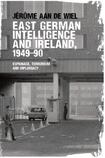
Sometimes dead men do tell tales, although not always the ones you’d like to hear. That’s the lesson of this engrossing study of East Berlin’s contacts with Ireland until the socialist German state vanished, in 1990.
Although the work carries the racy subtitle Espionage, Terrorism and Diplomacy, Jérôme aan de Wiel doesn't airbrush the central dilemma of his subject: relations between East Berlin and Dublin were, frankly, not very racy at all.
But this hasn’t compelled aan de Wiel, a Dutch-French lecturer in history at University College Cork, to produce a dusty volume. Instead he frames the book using what one East German dismissed as distasteful “corpse diplomacy”: the farcical, on-again off-again efforts to repatriate the remains of the Irish republican Frank Ryan. The Limerick man fought in the Spanish Civil War on the republican side and moved to Berlin in 1940, where he died of pleurisy four years later.
East Berlin’s appetite for exhuming Ryan’s remains after the war were dealt a blow when it learned of his wartime contacts with the SS. Dublin’s interest in the business was equally low, given its embrace of the Hallstein doctrine, which accepted the Bonn administration of the West German federal republic as Ireland’s only legitimate German partner.
This diplomatic stance, combined with limited economic ties, meant that contacts between Ireland and East Germany were kept to a minimum. Even the celebrated playwright and poet Bertolt Brecht was refused permission to visit Dublin in 1953.
After several false starts, however, the repatriation went ahead, in 1979, as a “humanitarian act” and as an East Berlin favour to the Communist Party of Ireland. And, as some in East Berlin hoped, it opened the door to diplomatic ties a year later. The Irish Embassy in The Hague was double-accredited to East Germany; East Berlin’s embassy in London took up duty for Ireland.
Low intelligence priority
Given that just nine years was left on East Germany’s clock, the book shifts its focus to a study of East German interest in Ireland – which began as a low priority, aan de Wiel acknowledges, and diminished still further as time went by.
As he explains, and I can testify, the bulk of Stasi information gathering on Ireland amounts to several folders of yellowing press cuttings. The few intelligence reports that exist are less interesting for their contents, often plagiarised from books, than for their sprinkling of factual and typing errors.
As aan de Wiel relates, Stasi moles at EEC institutions and the Belgian foreign ministry provided information on events in Northern Ireland, although again of a limited quantity and quality. The files reveal no evidence of an Irish Kim Philby selling secrets to East Berlin.
Despite – or rather because of – this lack of revelations, aan de Wiel’s study has a value on two levels. First, he provides an intelligent and timely corrective to competing narratives on the Stasi that have emerged since the East German secret police was wound up, a quarter century ago.
One narrative, egged on by the entertaining Oscar-winning film The Lives of Others, presents the Stasi as a pitiless, bloodless bureaucracy, where all-seeing agents with unlimited resources ruined people's lives.
Zersetzen
policy
Another narrative, spun by the foreign intelligence head Markus Wolf and swallowed by many beyond East Germany, presented the Stasi as a secret service like any other. This is also a distortion, given the Stasi’s cruel policy of
zersetzen
– grinding down ordinary citizens to achieve arbitrary ends, without Stasi officers having to worry about the legal ramifications of their actions.
Given its limitations, the Stasi was an effective intelligence service. But, wielding his academic shears expertly, aan de Wiel trims the service down to size and strips it of lingering mystique. Which leads to the second achievement of his book: what he didn't find in the 6,000 pages of Stasi files on Ireland, namely evidence that East Berlin had anything more than an observer's interest in Northern Ireland affairs.
The author does a good job of putting in context contacts of the IRA, both Provisional and Official, with Moscow. He also details how East Berlin monitored the Provisional IRA and INLA campaigns against British army bases in West Germany. But what of the shadowy contacts between Belfast and East Berlin that pop up in many standard works on the Troubles? According to aan de Wiel, many of these works, such as Ed Moloney’s history of the IRA, make claims that are not backed up with evidence.
Was there anything more than provincial vanity to the claims the Stasi saw itself obliged to support a republican campaign against British imperialism? The author says that “not a single sheet proves or even hints that the Stasi assisted the OIRA, PIRA or INLA by providing either finance or armament”.
That puts the ball back in the court of many journalists, historians and writers in Northern Ireland to produce the evidence that their IRA-Stasi claims are more than wishful thinking.
Derek Scally is Berlin Correspondent











